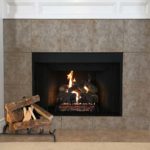If you’re new to fireplace operation, one of the questions you’re likely wondering is, what is a chimney damper? Or even, how does a chimney damper work?
You’re certainly not alone with these questions. Most homeowners would tell you that enjoying a stunning and warm fireplace is incredibly easy; however, knowing how to operate one successfully is just the opposite.
Making sure your damper is operating properly is essential to keeping your home warm and pushing toxic smoke outside. So, unless your type of fireplace is ventless, you must have a proficient understanding of dampers before operating it this winter.
To begin this crash course blog, let’s first define what it is and how to open and close it.
How to Open and Close Your Chimney Damper
A chimney damper is a manual mechanism that controls airflow and smoke through the chimney flue.
A closed damper acts as a seal that keeps the exterior air out and the interior air in. In contrast, an open one sends carbon-monoxide-rich exhaust through the flue and also assists in starting and controlling a fire.
The question is, how do you open and close a damper? The answer to this question is dependent on the specific type in your unit. There’s a multitude of different styles, but most homes have either a throat or top-sealing damper. We’ll dive into identifying the specific types of dampers in the subsequent section.
You will find the throat damper’s handle at the base of the flue. When the fireplace is thoroughly cooled, you must reach into the firebox and push or lift the handle to open the plate.
Top-sealing chimney dampers are significantly easier to open because the handle is mounted on the side of the fireplace wall. Pull or push the handle until it’s secure on a hook or notch. If it springs up and doesn’t feel secure, that means the door is open.
Types of Dampers
As mentioned in the previous section, the amount of chimney flue dampers utilized worldwide is voluminous. To keep this post from being 10,000 words, we will focus on the two most common types of chimney dampers: throat and top-sealing.
Throat:
These are the traditional types often found in masonry systems. It features a cast iron or steel handle that lifts a large metal plate. This plate essentially opens a door that separates the flue and firebox.
Your specific type of throat damper handle is likely either a poker, rotary, or pivot.
- Poker: Also known as vestals, this type is shaped similar to a banana and has fishbone-like grooves that hold it in place. To open the chimney damper, push the handle up until you’ve reached your preferred opening position. To close it, pull the handle down until you hear a thud sound.
- Rotary: This type opens by way of rotating a key-like component on the side of the fireplace. Rotate the key left or right to open and close it.
- Pivot: Pivot is a slightly more complex version of the poker handle. It’s shaped the same, except this handle is jointed and has notches on it, allowing the user to set it to different heights. It opens and closes identical to the poker, except you push or pull the handle back and forth with the notches.

Poker Handle

Rotary Damper

Top-sealing damper chain

Top-sealing handle
Top-Sealing:
Also known as chimney cap dampers or top-mounted, these feature a small, spring-loaded door located inside the cap, at the top of the chimney A steel cable stretches from the mounted handle, through the flue, and to the spring-loaded door in the cap.
Older top-mounted styles feature a long chain as the handle, while more contemporary versions feature a black handle that you push and pull to operate.
Top-sealing is superior to the throat type because the handle’s location is much more convenient to reach.
In addition to the easy access, since the door is inside the chimney cap, it prevents debris and animals from entering your flue. They’ve also proven to be the most effective type for keeping warm air inside homes.
When to Open and Close Your Damper
When a fire is burning in the firebox, it should always be in an open position. Only close it when the system is cool and not in use. This will keep the outside air from entering the home and the inside air from escaping through the flue.
A major benefit to chimney dampers is the ability to control and throttle your fires.
Damper handles have notches that you will use to throttle the airflow through the flue. Once you establish the fire, you can reduce its position by selecting a notch that narrows the opening. It would be best if you did this with extreme care.
Open Chimney Top Damper
If it’s only 1/2 open, smoke, fumes, and carbon monoxide can enter the home from the fireplace. However, suppose you’re sure no smoke is spilling into your home. In that case, a throttled damper will save on excess air leaving your home, and you will have a longer, more enjoyable fire.
By reducing the air escaping outside, you will have a warmer home without the furnace working overtime to keep up.
How to tell if the fireplace damper is open or closed
The best way to tell if it’s open or closed is by doing a visual inspection, checking the controls, or feeling for a draft.
It’s best if you visually check your throat damper plate. If it’s fully open, you’ll see into the chimney flue. If the plate is only partly open, an adjustment to the handle will widen this view. Sometimes the plate doesn’t seem completely open due to a chimney maintenance or repair issue.
The only way to be sure you’re correctly controlling it is (with safety glasses) to observe the chimney damper’s position as you’re operating the handle. Many make a loud thud sound, giving the homeowner a satisfying assurance that it’s closed. Of course, it’s easier to do this with a top-sealing handle.
If the top-sealing handle chain is hanging, the door is usually closed. If it’s latched or hooked into a notch, it’s open.
Another way to check is by feeling for a breeze or draft. If you put your hand in the firebox and feel cold air circulating or coming down the flue, then it’s open.
Chimney Damper Maintenance Cost
If your chimney damper won’t open, it’s likely damaged, off its track, or debris is blocking it from inside the flue.
It is very challenging (and dangerous) to have a wood or gas fire in the fireplace with a partial operational damper. So, if you’re experiencing any issues, you need to call a certified chimney technician.
Chimney dampers are subject to debris coming down the flue and can be affected by soot and creosote. The plate must be free of leaves, animals, bricks, mortar, soot, and creosote to operate safely and efficiently.
As they’re subject to high temperatures, warping of the frame and plate also becomes a problem.
Damaged dampers are a safety matter. You should never use fireplaces with broken mechanisms until you hire a professional to repair them.
Like the rest of your hearth and chimney, annual chimney damper maintenance is a must.
The repair cost depends on the severity of the issue. If you’re concerned about your system, or it’s been over a year since your last chimney service, contact your local chimney sweep to schedule an inspection.
Summary
Knowing how to keep your fireplace damper open or closed is an integral part of safely and successfully operating your fireplace.
Dampers are so important because they help start and control fires, release toxic smoke to the outdoors, and prevent indoor air from escaping and outdoor air from entering.
With the various types and styles, the novice fireplace operator can easily be confused about how their specific type works. But if you follow the directions provided in this blog post closely, we guarantee that you will adequately understand chimney damper operation.
If you’re experiencing issues opening yours or are still not confident about its safety, call your local chimney company to schedule an appointment with a certified professional!





